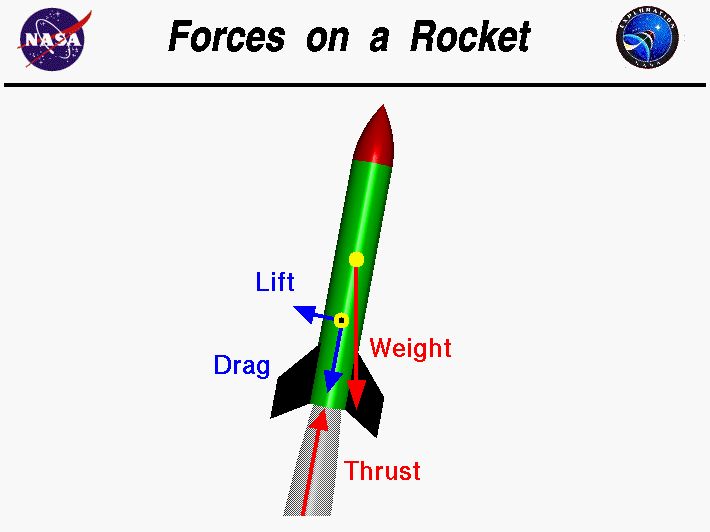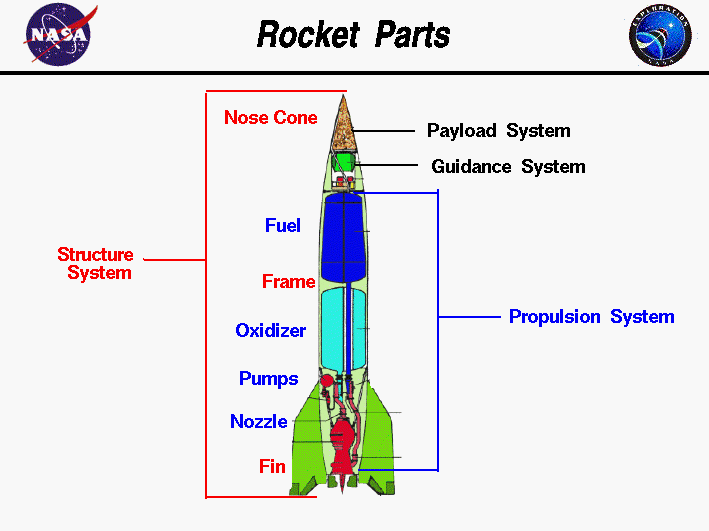Forces on a Rocket
A force is anything that can influence a change in speed or direction of an object. For rockets, there are four key forces that affect how a rocket flies.

Drag - Drag is created by air resistance. Imagine running down a track with a small parachute attached to your back. You would notice that it is more difficult to run with the parachute pulling you back versus running with no parachute. The parachute, in this example, causes considerable drag. When a rocket flies through the air, drag pushes back - or resists the rocket's forward motion. A rocket's drag is affected by shape, texture, velocity, as well as other factors.
Lift - On a rocket, Lift is a side force used to stabilize and control the direction of flight. This is quite different from the concept of lift as it relates to an airplane. On an airplane, lift is a force that overcomes weight to enable flight. In the Rockets application, we will simply discuss the concept of stability to avoid confusion.
Thrust - This is the force that produces lift-off, or upward movement of a rocket. Thrust is produced by engines or some other form of propulsion system. For lift-off to be achieved, thrust must exceed weight.
Weight - A combination of factors affect the weight of a rocket and can include cargo, passengers, fuel, parts of the rocket, materials, and other items. Weight is related to mass, but also includes the gravitational pull of the Earth.
Principal Axes of a Rocket
Rockets move a lot in flight. We can define this movement and control it by understanding how a rocket moves. There are three key axes that define this movement: Roll (longitudinal), Pitch (lateral), and Yaw (vertical). Since a rocket always rotates about its center of gravity, these axes are typically drawn to meet at the center of gravity.

The Three Axes
The longitudinal (roll) axis runs lengthwise down the rocket. The rockets tends to twist about this axis.
The lateral (pitch) axis runs side-to-side. Think of being on a seesaw and moving up and down. That up and down movement is your pitch and it occurs along a lateral axis.
The vertical (yaw) axis runs top-to-bottom. On a rocket, yaw is very similar to pitch except that the nose moves side-to-side.
On a "real" rocket, movement along these axes is controlled by adjusting the thrust direction, placing rudders on the fins, and other techniques. For a water rocket, we have to pay close attention to the location of the center of gravity and center of pressure (more on that later).
-

Roll
-

Pitch
Parts of a Rocket
There are many parts that make up a rocket. These parts are classified into the following systems: Structural, Propulsion, Guidance, Payload, and Recovery.

Structural System - The structure of the rocket typically consists of a nose cone, body, frame, fins, and other components depending on how the rocket will be used. These components are usually light weight yet very strong. Each component has a separate and important function. Here are just a few.
- The rocket's skin helps to control the internal temperature. This is critically important because the fuel and oxidizer must be kept cool. This is a tough job when rockets often reach extreme temperatures. The space shuttle was designed to handle an external temperature of 3,000 °F on atmospheric reentry!
- The shape of the nose cone is used to help reduce drag. Also the nose cone may protect the payload, guidance, and recovery system for the rocket.
- The fins of the rocket are important for maintaining stability. Without the fins the rocket would rotate uncontrollably about all three axes.
- The frame, or body, helps to maintain the structural integrity of the rocket.
Propulsion System - In the picture it is easy to see that the rocket consists of mostly the propulsion system. The propulsion system must produce enough thrust to overcome weight and drag to achieve lift-off. There are two main types of rocket propulsion: solid and liquid fuel. The above picture is a liquid fuel propulsion system. Both types of rocket propulsion are still used.
Guidance System - A guidance system may be a combination of sensors, computers, GPS, and communicators. The guidance system has two main roles during the launch of a rocket; to provide stability for the rocket, and to control the rocket during maneuvers.
Payload System - Payload is what the rocket is carrying. The payload depends on the rocket's mission. The payload could be a satellite, a human, or even an explosive device. Many rockets were designed so that different payloads could be carried with the same rocket.
Recovery System - Although not pictured above, the recovery system is one of the most important systems. Rocket recovery systems are an important aspect for safe rocket launching. A rocket recovery system should allow the rocket and possibly payload to land undamaged.
Weather Elements and Rocketry
Understanding the systems of a rocket and how they work together to produce flight is very important, but they are not the only things to take into consideration. Weather is very vital to how a rocket flies. It must be monitored closely to prevent accidents. Monitoring weather includes watching the different cloud types and air masses which can provide evidence of weather hazards including thunderstorms, snow, fog, and other inclement weather conditions. Another factor to remember is that conditions can be different not only due to weather but also due to the different levels of atmosphere. Aerodynamic designs are altered based upon the layer of atmosphere a rocket flies through.